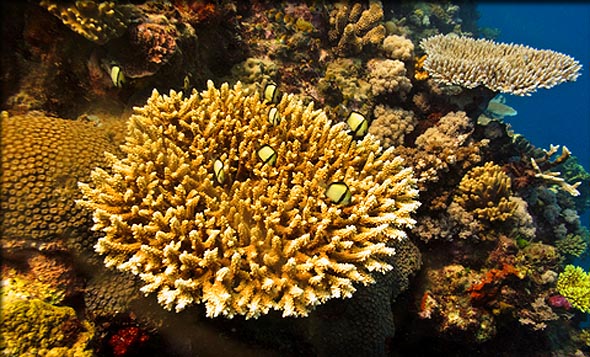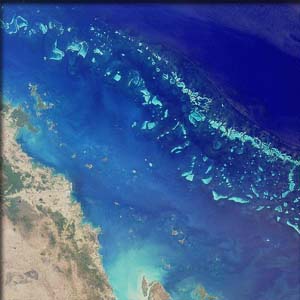|

Branching
Coral and Soldier Fish on the Great Barrier Reef (©
Pniesen | Dreamstime.com)
|
Just before 11
pm on June 11th, 1770, the HMS Endeavour, captained by Lieutenant
James Cook, ran aground. Cook had been exploring the northeast
coast of Australia when the accident occurred. The ship was
stuck fast on a reef and the crew made desperate attempts
to refloat her by lightening the ship. This meant throwing
anything not immediately useful overboard, including the ship's
ballast and most of its cannon. Long boats were then used
to carry the ship's anchors away from the reef and secure
them to the bottom. By winching in chains attached to the
anchors, the ship gradually pulled itself off the bank. The
reef had torn a hole in the bottom of the ship, however, and
the Endeavour was quickly taking on water. Working feverishly
the crew managed to temporary plug the leaks. They then sailed
for the safety of the shore where the ship was breached and
repaired.
Though Cook hadn't
realized it at the time, the coral reef he had run onto was
part of a vast system of 3,800 coral banks and islands that
ran along the coast of Australia. Known as the Great Barrier
Reef, it has a length of 1,600 miles (2,600 km) and covers
133,000 square miles (344,400 sq. km). It is the largest structure
in the world created by living organisms and supports a wide
diversity of life, including fish, whales, dolphins and sea
turtles. For this reason coral reefs are often referred to
as the "rainforests of the ocean."
|
Seven
Quick Facts
|
| Length:
1,600 miles (2,600 km). |
| Area:
133,000 square miles (344,400 sq. km). |
| Depth:
Surface to between 150 feet and 400 feet depending
on how far light can reach below the surface in a particular
location. |
| Discovered:
The Australian Aboriginals have been aware of the reef
for 40,000 years. The first European to notice it was
French explorer Louis de Bougainville in 1768. |
| Location:
Off the Northeastern coast of Australia. |
| Age:
20,000 years. |
| Other:
Often referred to as the largest structure in the world
created by living organisms. |
Coral Polyps
A coral reef forms
underwater when thousands of tiny animals, only a few centimeters
in length, establish a colony. These coral polyps build themselves
hard, carbonate, exoskeletons to protect their bodies. When
the polyps die they leave these exoskeletons behind and this
becomes the surface on which a new generation of coral polyps
can grow. Because one generation of coral builds on the last,
the coral can "grow" vertically from 1/3 of an inch to almost
one inch a year under good conditions. Their habitat is limited,
however, from the surface of the sea to the maximum depth
that light can penetrate the water, which, depending on conditions,
is between 150 feet to 400 feet in the open ocean. Most corals
can only thrive in warm tropic waters near the equator. If
the water temperature gets too cold, or too hot, they will
die.
The coral polyps
are animals that feed on a variety of small organisms, like
microscopic plankton or even small fish, using tiny tentacles
with poisonous stinging tips. After capturing the prey, the
tentacles contract and bring it to the polyps' stomach where
it is digested.
|

The
reef as seen from space. (NASA)
|
Many of the corals
also have a symbiotic relationship with a type of algae. The
algae live inside the polyp and use photosynthesis to give
the coral energy and help it build its exoskeleton (The sunlight
needed for the algae's photosynthesis is what limits how deep
the coral can live). In return the algae get a safe place
to live and they consume the polyps' waste products. The algae
also give the coral its color. Under certain conditions the
algae can put stress on the polyp and it will eject the algae
and turn white (an effect known as "bleaching"). If stress
continues on the coral it will die, so bleaching is considered
a sign that the coral is sick. If conditions return to normal,
however, the coral can regain algae and its color will return.
History
The most recent
incarnation of the Great Barrier Reef got its start 20,000
years ago when sea levels around the coast of Australia began
to rise after the peak of the last ice age. As glaciers began
to melt and flow into the sea the coastal plain near the northeast
Australia became flooded making hills on the plain into islands.
This area was shallow and warm enough for the coral to start
growing around the edge of these islands. As the water continued
to get deeper the coral grew upward keeping the living part
of the reef within range of the sunlight. These smaller coral
reefs grew larger but never completely merged so the system
is actually made up of thousands of separate reefs and coral
islands. There is also evidence that there are older versions
of the reef that grew in the gaps in between the earlier ice
ages. These may date back as far as 600,000 years.
Sea Life
There are over
400 different species of coral that inhabit the reef. Not
all of them, however, create the hard exoskeletons necessary
to build a reef. Those that do can take a number of different
forms. Brain coral grows in a rounded lump up to six feet
(1.8 m) in diameter. It gets its name from the convoluted
grooves that cover their surface that resemble the folds on
a brain. Table coral, elkhorn coral and staghorn coral grow
in various shapes with antler-like branches. Pillar corals
grow as a number of columns, or fingers, stretching up from
the sea floor.
Coral reefs are
a haven for sea life. They occupy less than one-tenth of one
percent of the oceans, but provide a habitat for a quarter
of all marine species. Over 1,500 types of fish live in the
Great Barrier Reef alone. These include the colorful clownfish,
angelfish and butterflyfish. Also, a large number of highly
poisonous animals live on the reef including the box jellyfish,
sea snakes, cone-shells and blue-ringed octopi. The top predator
on the reef is the Great White Shark.
The first humans
to become aware of the reef were Australian Aboriginal groups.
For the past 40,000 years the reef has provided them food
in the form of sea turtles and dugongs (Large marine mammals
related to the manatee). About 10,000 years ago the Torres
Strait Islanders also moved into the area. Like the aboriginals
they used wooden outrigger canoes to hunt and move from coral
island to island. The activities surrounding the hunting of
these creatures was of great cultural significance to these
peoples and the animals were an important resource. For example,
traditionally the shell of the sea turtle would be fashioned
into items such as combs and fishhooks.
|

Rare
bush of branching black coral. - (©
Caan2gobelow | Dreamstime.com )
|
The first European
to become aware of the reef was the French explorer Louis
de Bougainville who came through the area in 1768 on a trip
to circumnavigate the globe. He was searching for Australia
when he was forced to change course after seeing waves breaking
on the reef.
Protection of
the Reef
In recent years
efforts have been focused on protecting the Great Barrier
Reef from damage. In 1975 the government of Australia created
the Great Barrier Reef Marine Park which gives protection
to a large part of the reef system. Fishing and the removal
of coral or artifacts is highly regulated. Commercial shipping
traffic is restricted to certain lanes that avoid the most
sensitive parts of the park.
The park is a
popular tourist destination and much of the management effort
is directed at making sure these activities are ecologically
sustainable. Tourists can visit the reef on special glass
bottomed boats or see it from the air by helicopter. The most
popular way to visit the reef, however, is by snorkelling
or scuba diving. Approximately two million people travel to
the Great Barrier Reef each year which generates billions
of dollars of economic activity for the region.
The Great Barrier
Reef, along with many other coral reefs, is under threat from
a number of environmental problems. Global warming may increase
the water temperature to the point where the coral becomes
stressed enough to bleach. Coral bleaching events were recorded
on the reef in 1998, 2002 and 2006. Pollution can also damage
the reef. Fertilizers and pesticides used in farm production
can be carried out to sea and damage the fragile ecosystem.
The corals also
have a natural predator in the crown-of-thorns starfish. When
overfishing reduces the number of fish eating the starfish,
their numbers can skyrocket, allowing them to do great damage
to the reef.
Hopefully, careful
management by the Great Barrier Reef Marine Park Authority
will protect the reef from extensive damage. If so, it will
remain a natural wonder of the world for many generations
to come.

Copyright
2012 Lee Krystek. All Rights Reserved.